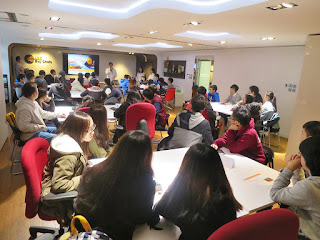The HKSQ Company
Based Student Project Competition offers
an opportunity for students to work on an actual industrial case and propose
resolution annually. It aims
to give opportunity for student to gain experience of
resolving an industrial problem. The
competition included three sessions. The
first session was problems selection which problems were designed and explained
by sponsor company – LSG Sky Chief in 2016.
The second session was plant visit and the last session was presentation
of their suggested solutions. The LSG
Plant Visit was held on 30 Jan 2016 and the group photo was taken for memory.
Mr. Peter Fung (Chairman, HKSQ)
led the visit and LSG shuttle bus carried students to the site.
HKSQ exco members and each
universities leaders coordinated students for this event.
In the beginning, Mr. Steward
Leung (Senior Lean Analyst) briefed the program and house rules.
Then Ms. Maggie Lam (HR
representative) briefed LSG Graduate Trainee Program in 2016 and the program
objectives were:
-
To recruit high-caliber career starter
-
To cultivate potential cadidates to be future professional leaders
-
To share experienced and skills to the trainee for supporting their
career development
She said the program period was
18 months where they would be attached in the assigned department for 15 months and rotated
to other Operational Departments for 3 months.
Operational Departments included Production, Airline Services,
Transportation and Warehouse. Their
career path were from Graduate Trainee to Supervisor to Officer to Senior
Officer to Assistant Manager and finally to Manager. The recruitment Timeline is show as following
diagram.
Before plant visit, we needed to wear uniform like lab coat and slip resistant shoes.
We separated into two teams to
visit the plant and Mr. Eddy Yung (General Manager) led the first team.
We went to warehouse and then to vegetable room. In here, all students needed to wash their hands.
Inside the plant, we visited
different function areas and some photos taken for recording.
Before lunch, we discussed the
topic in meeting room separately. Some photos were taken for each team with
their supervisors for memory.
PolyU
CityU
HKU
HKUST
CUHK
In afternoon session, we
separated into three teams for three topics and went to their specific process
line for detail study.
After that we were back to
meeting room and discussed again. Students would think what further data and
information they needed to collect from LSG.
We finished the whole field study
at 4:00pm.
Reference:
HKSQ Company Based Student
Project Competition - http://www.hksq.org/company_based_competition.htm
LSG Sky Chefs - http://www.lsgskychefs.com/
20160122: HKSQ Student Project Competition 2016 - Briefing - http://qualityalchemist.blogspot.hk/2016/01/hksq-student-project-competition-2016.html

























































